Factory No. 10, 5th District of New Jersey (Jersey City)
The Pan Handle Scrap brand was issued by the American Tobacco Company and tied exclusively to Factory No. 10, 5th District of New Jersey. Unlike other T68 brands such as Royal Bengals or Miners Extra, Pan Handle Scrap was marketed as chewing tobacco, composed of loose cuttings and remnants also usable for pipe, chewing or roll-your-own. These cards stand out as the only examples stamped “Factory No. 10, 5th Dist. N.J.,” anchoring them firmly to the Jersey City manufacturing hub. Collectors prize them for their relative scarcity, distinctive branding, and the visible evidence of tobacco contact many examples bear. Some Pan Handle cards display brown toning or oil absorption from extended storage within scrap packages, offering a tangible connection to their original environment.

A Passion for Tracing Origins
Factory No. 10 served as part of American Tobacco Company’s New Jersey branch operations, a smaller but specialized site within ATC’s vast network. Whereas Factory 2 (Lorillard, Jersey City) and Factory 17 (Richmond) handled some of the most widely distributed brands, Factory 10 carried a more niche product line. Its exclusive link to Pan Handle Scrap in the T68 issue provides collectors with one of the clearest single-factory attributions in the entire series.
Historic Factory Site
Factory 10 was almost certainly located in Jersey City’s industrial corridor, within close reach of rail and shipping terminals. This placement allowed American Tobacco to distribute Pan Handle Scrap efficiently throughout the mid-Atlantic and northeastern markets. While less documented than the larger Lorillard facility, Factory 10 demonstrates how ATC used smaller plants to push brand diversity and maintain wide geographic coverage.
Factory Stamp Identifier
Every Pan Handle Scrap T68 reverse carries the distinctive “Factory No. 10, 5th Dist. N.J.” imprint. For collectors, this marking provides critical proof of origin and distinguishes Pan Handle Scrap from all other back types. In building a master set, this factory stamp remains a key element in confirming provenance.
Packaging Realities and Tobacco Staining
Unlike card inserts from sealed cigarette packs, Pan Handle Scrap cards were housed within packages of loose chewing scrap tobacco. As a result, many surviving examples absorbed staining, toning, or even the faint aroma of the product itself. Edge darkening, uneven discoloration, and subtle oil shadows on card stock are common and considered authentic indicators of their storage history. High-grade Pan Handle Scrap cards are elusive, and packaging evidence reinforces their unique preservation story.
Pan Handle Branding and Advertising
The Pan Handle Scrap brand projected bold, straightforward value. Advertisements and packages used heavy block lettering, strong color contrast, and the prominent P-H target logo. Marketed as an economical product, Pan Handle Scrap was positioned for everyday tobacco users, while the collectible insert served as added incentive.
Shades of Blue
Collectors have long noted multiple shades of blue ink on Pan Handle Scrap backs. These are broadly classified into three types:
- Deep Navy — bordering on black, heavily inked, often producing dense impressions, rare versions.
- Mid Blue — the standard issue tone, more frequently encountered.
- Light Blue — brighter, less saturated, producing a softer visual contrast most frequently encountered.
These variations likely reflect different ink batches or press runs at Factory 10. For advanced collectors, assembling a trio of all known shades represents a milestone in completing a Pan Handle Scrap subset.
Silver Backs
A rarer and more enigmatic variation within Pan Handle Scrap is the “Silver Back.” These examples show noticeably lighter, almost metallic blue-gray ink instead of the usual blue tones. While some argue these arose from depleted pigment or diluted ink mixes, others suggest experimental runs or deliberate design adjustments. Distribution evidence indicates that Silver Backs were produced in smaller quantities, likely late in the printing cycle. Their limited survival rate makes them significantly harder to acquire, and they are regarded among the most prized Pan Handle issues.
Attributed to American Tobacco Company Lorrillard Facility in Jersey City, NJ
(Factory No. 10, 5th DIST)
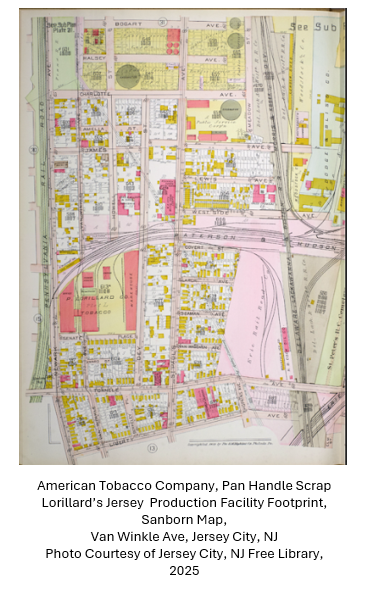
Historic Factory Site
While the precise footprint of Factory 10 remains less documented than Lorillard’s operations, records place it firmly within Jersey City’s waterfront manufacturing zone. Proximity to rail and shipping terminals made it ideal for distributing chewing scrap tobacco across the Northeast. Factory 10 illustrates how ATC relied on smaller satellite plants to diversify its brand presence, using Pan Handle Scrap as a low-cost product with collectible appeal.
Distinctive Back Stamp
Collectors can immediately identify Pan Handle Scrap cards by the “Factory No. 10, 5th Dist. N.J.” back stamp. This factory marking is unique to the brand and separates Pan Handle Scrap from all other backs in the Heroes of History series. For set builders, this factory stamp remains the essential hallmark of Jersey City provenance.
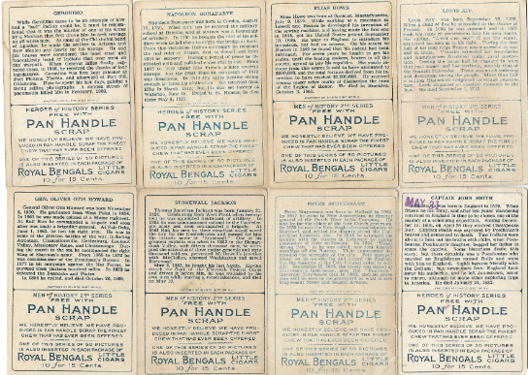
Factory Stamp Location
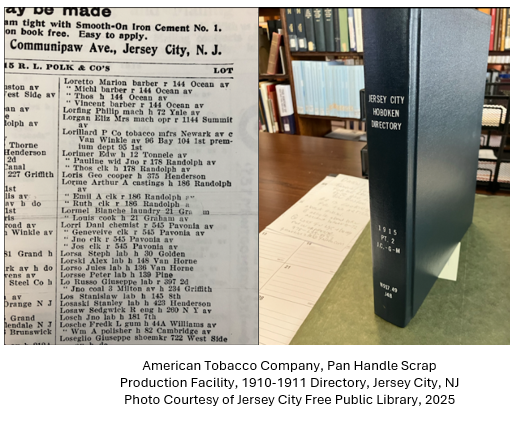
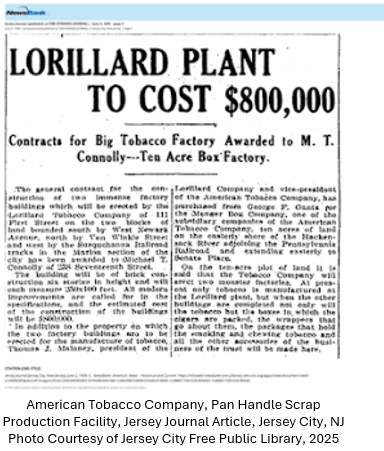
“Jersey City thrived as a tobacco crossroads, where factory smoke mingled with the harbor air and every package bore the stamp of its industrial might.”
– Early 20th-century Jersey City trade commentary
Pan Handle Scrap Branding/Insertion Highlights
- Associated with American Tobacco Company’s Jersey City operations, tied exclusively to Factory No. 10, 5th Dist. N.J.
- Inserted into Pan Handle Scrap chewing tobacco packages, confirmed by back stamps reading “Factory No. 10, 5th Dist. N.J.”
- Packs prominently featured the bold P-H target logo and block lettering, projecting straightforward value to everyday consumers.
- Packaging emphasized Jersey City’s industrial identity, with branding that tied the product to ATC’s mid-Atlantic production hub.
- Coupons included in Pan Handle Scrap packages extended ATC’s marketing reach, offering redemption programs and premiums, while reinforcing brand loyalty.
- Cards found with Pan Handle Scrap form a distinct Factory 10 subset, separating them from the more widely distributed Factory 2 and Factory 17 issues.
- Reflects ATC’s strategy of pairing economy chewing scrap brands with collectible cards, highlighting Jersey City’s role as a specialized insertion point in the T68 release.
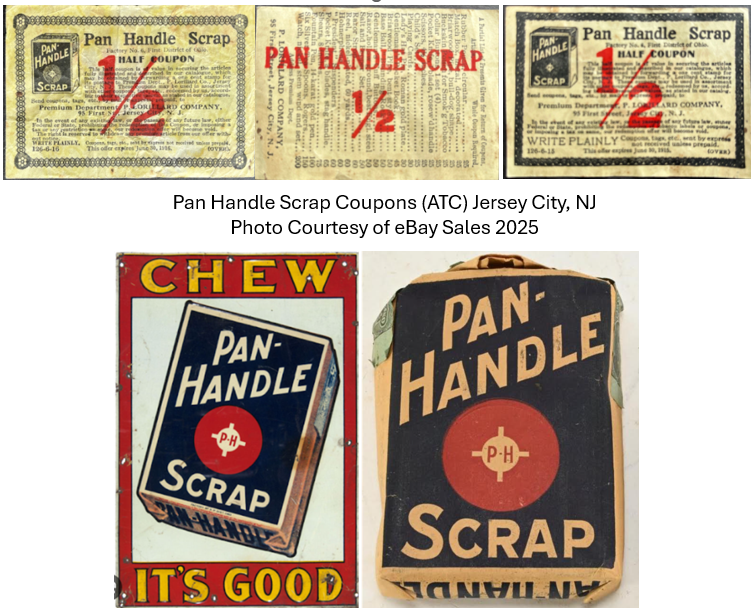
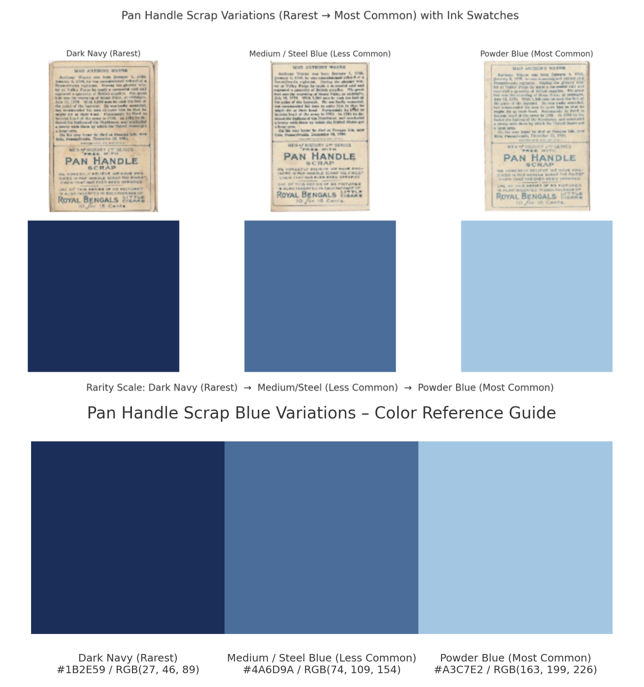
Pan Handle Scrap Shades of Blue Highlights
- Collectors have identified three distinct blue ink shades on Pan Handle Scrap backs, not just one general “blue.”
- The three stable shades are:
- Dark Navy (#1B2E59) – nearly black, rarest
- Medium/Steel (#4A6D9A) – balanced blue tone, less common
- Powder (#A3C7E2) – pale and airy, most common
- These shades are repeatable production variations, not fading or sun damage, confirmed by consistency across multiple cards.
- Identification requires neutral daylight or 5000K lighting, use of a white background, and side-by-side comparison of “PAN HANDLE” lettering.
- Differences stem from ink batch drift, press settings, and paper absorption, not age deterioration.
- Market observations suggest Dark Navy is rarest, Steel less common, and Powder most frequently seen.
- Collectors can pursue a three-blue run for a subject, adding depth and challenge to Pan Handle Scrap set building.
- A documentation standard exists: photograph under neutral light, record RGB values, and archive with subject and date for reliable cataloging.
- Recognition of shades would improve auction listings, registry accuracy, and collector valuation, much like acknowledged color variants in other tobacco issues
Pan Handle Silver Backs
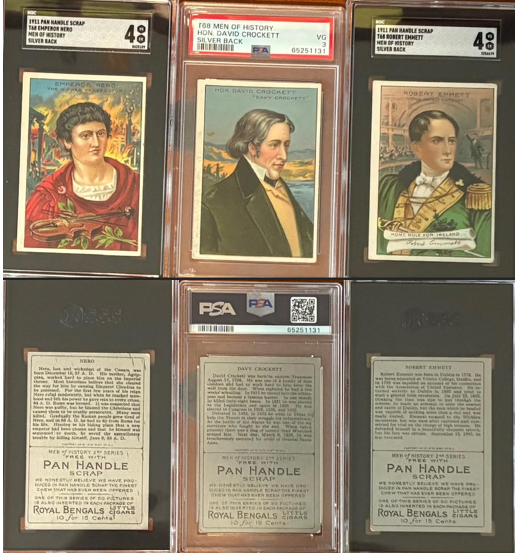
Factory No. 10, 5th District of New Jersey (Jersey City)
Origins of the Silver Back Variation
Among the T68 Heroes of History subsets, the Pan Handle Scrap “Silver Back” stands out as one of the most elusive and debated factory variations. Stamped exclusively with “Factory No. 10, 5th Dist. N.J.”, these cards were inserted in packages of Pan Handle Scrap chewing tobacco produced in Jersey City. Unlike the standard Deep Navy, Steel, and Powder blue tones, Silver Backs present a noticeably lighter, almost metallic blue-gray tone. This consistent appearance across multiple subjects confirms intentional production differences rather than post-distribution fading or deterioration.
Production Methods and Coating Process
Early 1910s lithography relied on heavy batch printing, with ink color determined by pigment ratios, binding agents, and roller calibration. The Silver Back tone appears to result from one of two plausible production processes:
- Pigment Substitution or Dilution — Printers at the American Lithographic Company may have reduced the concentration of Prussian Blue pigment, resulting in a pale gray-blue impression that collectors now interpret as “silver.” This is reinforced by the uniform coverage across the back text rather than patchy fading. Period production often adjusted pigment strength depending on availability, and lighter runs could emerge when expensive pigments were stretched.
- Surface Coating or Binder Alteration — Surviving Silver Backs display a faint reflective sheen not present on standard blues. This suggests either a varnish or binder with higher clay content, or a lighter ink vehicle that left pigment sitting closer to the paper’s surface, amplifying reflectivity. Period trade journals note that economy print runs often experimented with cheaper pigment or altered coatings when stocks of darker ink were depleted. Yet the particular sheen of the Silver Backs hints at more than just thrift. The reflective finish could also point to the use of a gloss varnish or clay-charged coating deliberately applied to protect the backs or enhance their appearance. Such treatments would have made the surface more light-reactive, giving the illusion of metallic ink under certain angles. If this was a controlled experiment, the higher material cost of specialty varnish or binder may have limited production to a short run. This would explain both the rarity of Silver Backs today and their distinctive look compared to the standard Navy, Steel, and Powder blue tones.
- Plate Wear and Press Pressure —Another contributing factor may have been plate wear combined with reduced press pressure, which left text with thinner, less saturated impressions that sometimes appeared almost etched into the stock. When this lighter inking was paired with paper containing higher clay content or tighter sizing, the natural reflectivity of the paper fibers showed through more strongly. This interaction between worn plates, lower pressure, and reflective paper surface could have amplified the metallic effect, giving Silver Backs their distinctive sheen compared to standard Pan Handle blues.
Cost of Production
American Tobacco Company was notoriously efficient in controlling costs. Standard blue backs relied on high-density Prussian Blue pigment, a relatively expensive import in 1910–1911. Substituting or diluting pigment with a cheaper binder could have reduced expenses by 15–20% per print batch, and in bulk production this represented meaningful savings. From this perspective, Silver Backs may have originated as a cost-control measure or a response to limited pigment supply.
However, another possibility is that the heavy metallic coating used on Silver Backs was actually more expensive to produce. If so, ATC may have discontinued the process quickly, generating a naturally shorter production run. This would explain why Silver Backs survive today in such small numbers and why they feel more like an intentional premium anomaly than an economy measure. Whether created through thrift or experimentation, the result is the same: a rarity born from Factory 10’s production decisions, carrying a legacy of exclusivity that collectors now prize.
Distribution and Survival Rates
Silver Backs were packaged identically to standard Pan Handle Scrap cards inside chewing scrap pouches, meaning they endured the same staining, oil absorption, and handling risks. However, their lower production runs — likely a fraction of standard Navy/Steel/Powder runs — mean survival rates are disproportionately low. Today, they surface sporadically at auction, and collectors pay a premium for these rare backs.
Collector Significance
Silver Backs represent one of the most advanced challenges for Pan Handle Scrap specialists. Their combination of factory exclusivity, experimental production history, and extremely limited distribution elevates them to the top tier of rarity in the T68 set. Collectors who secure Silver Backs not only acquire scarce physical examples but also preserve evidence of ATC’s resourcefulness and printing economy at Factory 10.
T77 Sights and Scenes of the World — Pan Handle Scrap Parallel Issue
The T77 Sights and Scenes of the World series was issued by the American Tobacco Company around the same time as the T68 Heroes of History set and shares the same Pan Handle Scrap back design tied to Factory No. 10, 5th Dist. N.J. Unlike the martial and biographical subjects of T68, T77 highlighted famous landmarks, architectural achievements, and natural wonders, offering a cultural and geographic counterpoint.
Like the T68 Pan Handle Scrap cards, T77 examples were packaged with loose chewing scrap tobacco, meaning most surviving cards show staining and toning consistent with their storage environment. The use of the same bold Pan Handle Scrap advertisement and factory stamp confirms the cards’ Jersey City origins and positions them within the same production lineage.
For collectors, the T77 issue represents an important parallel set, demonstrating how ATC leveraged its economy scrap brands across multiple themes to broaden consumer appeal. The pairing of history (T68) and geography (T77) through the same brand underscores American Tobacco’s commitment to using inexpensive chewing scrap products as vehicles for wide-ranging promotional campaigns.
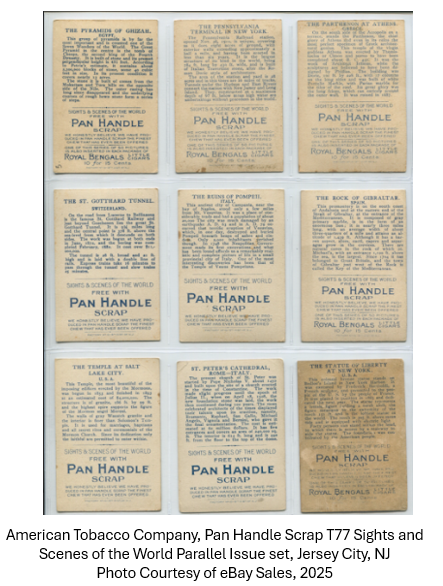
Pan Handle Scrap Grading: Authenticity and Collector Challenges
Grading the Pan Handle Scrap “Silver Back” subset has advanced significantly in recent years. Unlike the past, when Silver Backs were lumped under generic Pan Handle Scrap labels, both PSA and SGC now formally recognize the Silver Back variation. This distinction validates years of collector research and provides these cards with their own identity in grading reports and population data.
Standard Pan Handle Scrap backs—Navy, Steel, and Powder Blue—are still grouped together without separation, but Silver Backs now stand apart with distinct labeling. This recognition eliminates the old uncertainty about whether they were simply faded examples or intentional runs. Their consistent silver-gray ink tone across multiple subjects confirms that they were authentic production issues tied exclusively to Factory No. 10 in Jersey City.
Collector Implications
Challenge – Even with official grading recognition, Silver Backs remain scarce. Population numbers are extremely low compared to standard Pan Handle issues, and raw examples are still sometimes misidentified as “faded” blues.
Opportunity – With PSA and SGC labels now acknowledging the variation, collectors can pursue Silver Backs as a validated subset of Pan Handle Scrap. Their scarcity and factory exclusivity make them one of the most desirable chase elements in the T68 run, and demand is expected to increase as registry competition grows.
Future Recognition
The acknowledgment of Silver Backs by PSA and SGC represents a major step forward in Pan Handle Scrap scholarship. The next horizon may be the recognition of the three distinct production blues (Navy, Steel, and Powder), which advanced collectors already track and document. If those are ever added to census reports, Pan Handle Scrap will become one of the most nuanced graded subsets in the entire T68 series.
For now, Silver Backs have secured their place as a recognized and authenticated variation, standing at the pinnacle of Factory 10’s output and offering collectors both rarity and historical significance. The Shades of Blue is the next level of pursuit with this unique T68 Masters subset.
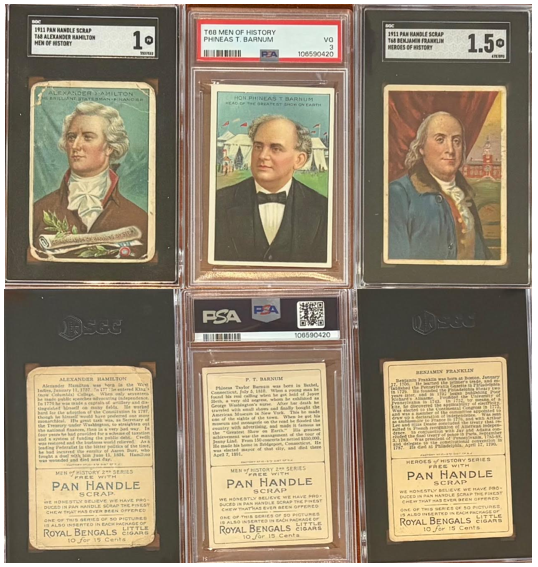
“The Silver Back is more than a printing oddity — it is a window into the American Tobacco Company’s balancing act between cost, efficiency, and marketing, stamped forever with the mark of Jersey City’s Factory 10.”
– Collector Commentary
Collector Reflection